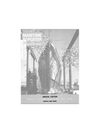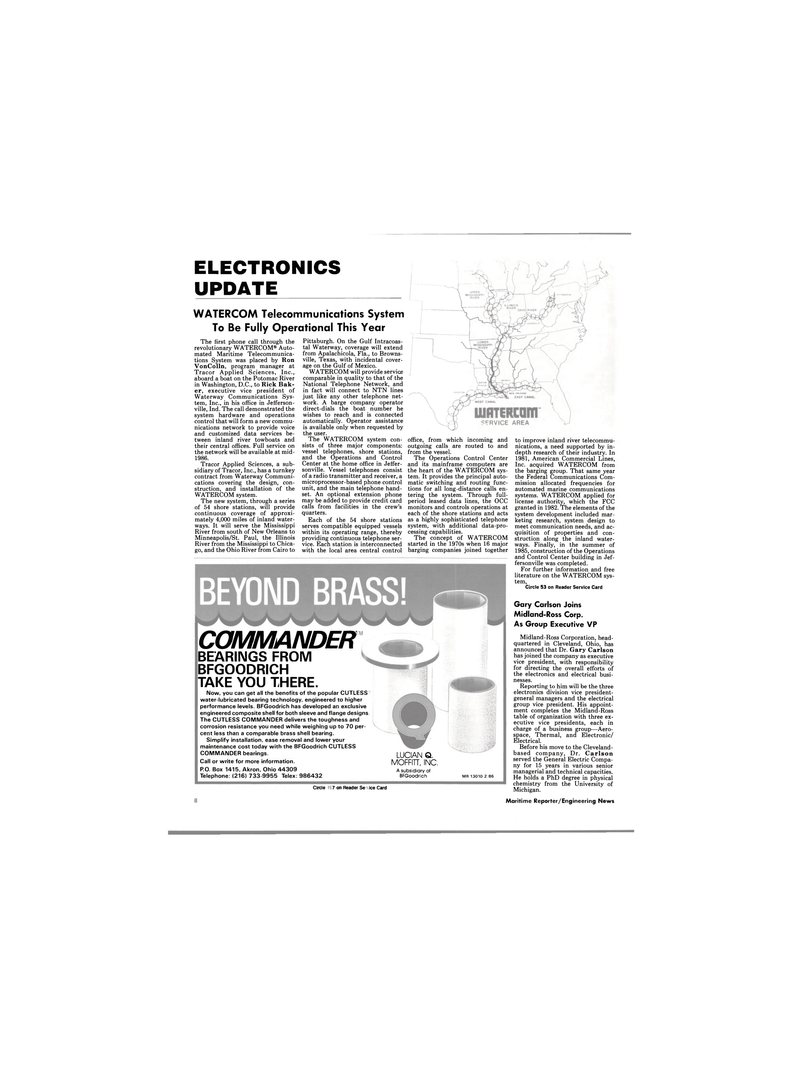
Page 6: of Maritime Reporter Magazine (March 1986)
Read this page in Pdf, Flash or Html5 edition of March 1986 Maritime Reporter Magazine
ELECTRONICS
UPDATE
WATERCOM Telecommunications System
To Be Fully Operational This Year
The first phone call through the revolutionary WATERCOM® Auto- mated Maritime Telecommunica- tions System was placed by Ron
VonColln, program manager at
Tracor Applied Sciences, Inc., aboard a boat on the Potomac River in Washington, D.C., to Rick Bak- er, executive vice president of
Waterway Communications Sys- tem, Inc., in his office in Jefferson- ville, Ind. The call demonstrated the system hardware and operations control that will form a new commu- nications network to provide voice and customized data services be- tween inland river towboats and their central offices. Full service on the network will be available at mid- 1986.
Tracor Applied Sciences, a sub- sidiary of Tracor, Inc., has a turnkey contract from Waterway Communi- cations covering the design, con- struction, and installation of the
WATERCOM system.
The new system, through a series of 54 shore stations, will provide continuous coverage of approxi- mately 4,000 miles of inland water- ways. It will serve the Mississippi
River from south of New Orleans to
Minneapolis/St. Paul, the Illinois
River from the Mississippi to Chica- go, and the Ohio River from Cairo to
Pittsburgh. On the Gulf Intracoas- tal Waterway, coverage will extend from Apalachicola, Fla., to Browns- ville, Texas, with incidental cover- age on the Gulf of Mexico.
WATERCOM will provide service comparable in quality to that of the
National Telephone Network, and in fact will connect to NTN lines just like any other telephone net- work. A barge company operator direct-dials the boat number he wishes to reach and is connected automatically. Operator assistance is available only when requested by the user.
The WATERCOM system con- sists of three major components: vessel telephones, shore stations, and the Operations and Control
Center at the home office in Jeffer- sonville. Vessel telephones consist of a radio transmitter and receiver, a microprocessor-based phone control unit, and the main telephone hand- set. An optional extension phone may be added to provide credit card calls from facilities in the crew's quarters.
Each of the 54 shore stations serves compatible equipped vessels within its operating range, thereby providing continuous telephone ser- vice. Each station is interconnected with the local area central control office, from which incoming and outgoing calls are routed to and from the vessel.
The Operations Control Center and its mainframe computers are the heart of the WATERCOM sys- tem. It provides the principal auto- matic switching and routing func- tions for all long-distance calls en- tering the system. Through full- period leased data lines, the OCC monitors and controls operations at each of the shore stations and acts as a highly sophisticated telephone system, with additional data-pro- cessing capabilities.
The concept of WATERCOM started in the 1970s when 16 major barging companies joined together
COMMANDER BEARINGS FROM
BFGOODRICH TAKE YOU THERE.
Now, you can get all the benefits of the popular CUTLESS water-lubricated bearing technology, engineered to higher performance levels. BFGoodrich has developed an exclusive engineered composite shell for both sleeve and flange designs
The CUTLESS COMMANDER delivers the toughness and corrosion resistance you need while weighing up to 70 per- cent less than a comparable brass shell bearing.
Simplify installation, ease removal and lower your maintenance cost today with the BFGoodrich CUTLESS
COMMANDER bearings.
Call or write for more information.
P.O. Box 1415, Akron, Ohio 44309
Telephone: (216) 733-9955 Telex: 986432
LUCIAN Q. MOFFITT, INC.
A subsidiary of
BFGoodrich MR 13010 2,86
Circle 237 on Reader Sen/ice Card to improve inland river telecommu- nications, a need supported by in- depth research of their industry. In 1981, American Commercial Lines,
Inc. acquired WATERCOM from the barging group. That same year the Federal Communications Com- mission allocated frequencies for automated marine communications systems. WATERCOM applied for license authority, which the FCC granted in 1982. The elements of the system development included mar- keting research, system design to meet communication needs, and ac- quisition of properties and con- struction along the inland water- ways. Finally, in the summer of 1985, construction of the Operations and Control Center building in Jef- fersonville was completed.
For further information and free literature on the WATERCOM sys- tem,
Circle 53 on Reader Service Card
Gary Carlson Joins
Midland-Ross Corp.
As Group Executive VP
Midland-Ross Corporation, head- quartered in Cleveland, Ohio, has announced that Dr. Gary Carlson has joined the company as executive vice president, with responsibility for directing the overall efforts of the electronics and electrical busi- nesses.
Reporting to him will be the three electronics division vice president- general managers and the electrical group vice president. His appoint- ment completes the Midland-Ross table of organization with three ex- ecutive vice presidents, each in charge of a business group—Aero- space, Thermal, and Electronic/
Electrical.
Before his move to the Cleveland- based company, Dr. Carlson served the General Electric Compa- ny for 15 years in various senior managerial and technical capacities.
He holds a PhD degree in physical chemistry from the University of
Michigan. 8 Maritime Reporter/Engineering News

 5
5

 7
7
